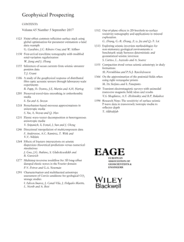
Full text loading...
In this paper, we discuss the effects of anomalous out‐of‐plane bodies in two‐dimensional (2D) borehole‐to‐surface electrical resistivity tomography with numerical resistivity modelling and synthetic inversion tests. The results of the two groups of synthetic resistivity model tests illustrate that anomalous bodies out of the plane of interest have an effect on two‐dimensional inversion and that the degree of influence of out‐of‐plane body on inverted images varies. The different influences are derived from two cases. One case is different resistivity models with the same electrode array, and the other case is the same resistivity model with different electrode arrays. Qualitative interpretation based on the inversion tests shows that we cannot find a reasonable electrode array to determine the best inverse solution and reveal the subsurface resistivity distribution for all types of geoelectrical models. Because of the three‐dimensional effect arising from neighbouring anomalous bodies, the qualitative interpretation of inverted images from the two‐dimensional inversion of electrical resistivity tomography data without prior information can be misleading. Two‐dimensional inversion with drilling data can decrease the three‐dimensional effect. We employed two‐ and three‐dimensional borehole‐to‐surface electrical resistivity tomography methods with a pole–pole array and a bipole–bipole array for mineral exploration at Abag Banner and Hexigten Banner in Inner Mongolia, China. Different inverse schemes were carried out for different cases. The subsurface resistivity distribution obtained from the two‐dimensional inversion of the field electrical resistivity tomography data with sufficient prior information, such as drilling data and other non‐electrical data, can better describe the actual geological situation. When there is not enough prior information to carry out constrained two‐dimensional inversion, the three‐dimensional electrical resistivity tomography survey is the better choice.

Article metrics loading...

Full text loading...
References


Data & Media loading...

